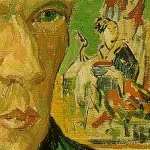
It's only a step, but a very gratifying one: A chapter from Yellow was just accepted for publication by The New Delta Review, a fine journal published out of LSU. The excerpt will appear in the spring, just as the magazine is switching to an online format. That's good news for anyone in the blogosphere who would like to get a little taste of my Van Gogh novel. I will certainly post about it when the issue is up and running. The chapter will run under the title "The Evangelist."
I'm quite happy at the news of this acceptance. Publishing novel chapters is always a tricky business. Some journals simply won't take them; others, understandably, only want to see novel chapters that work as stand alone stories. Culling one's novel for chapters that function that way is intriguing and delicate work, often requiring significant cutting and recombining. Fortunately, in Yellow, a somewhat episodic novel, I found several such chapters. ("The Evangelist" is the first to be accepted for publication.) Interestingly, more than a couple of these were chapters that featured a different point-of-view character than Vincent. I'm guessing the reason that these stood out is that they are literally stand alone in the novel itself, the only chapters which feature those particular point-of-view characters.
The chapter accepted by The New Delta Review, like all the novel's chapters, is told from the 3rd person limited point of view with the point of view character being one P. C. Gorlitz, a man who rooms with Van Gogh in Dordrecht. Gorlitz is an actual historical figure, one of those minor names who come up when you start to research Van Gogh's biography and read his letters. Very little is known about him now, except that he was a young schoolmaster when he shared a room in a boardinghouse with Vincent. In 1914 an article about Van Gogh, written by one M.J. Brusse, appeared in a Rotterdam newspaper. The article quotes from a letter Brusse received from Gorlitz in which Gorlitz recalls his months rooming with Van Gogh. I used a few of the details from Gorlitz's recollection to build my chapter, but the personality of the man himself and the core facts of his life, such as his attitude toward the teaching life, were utterly imagined. This, of course, is one of the great joys of historical fiction: taking an actual person and giving him a new life through the exercise of one's creative faculties. After writing the chapter I felt, of course, that the real Gorlitz must have been exactly like my Gorlitz. Well, maybe he was and maybe he wasn't; but in any case, my Gorlitz feels as real to me as anyone--living, dead, or imaginary. Is there a difference?













Congrats, John! It's often hard to place historical fiction, although I'm not sure why that it.
ReplyDeleteI know what you mean, Cathy. I don't quite understand it myself. But historical novels so seem much more prevalent than historical short stories. Maybe editors of journals are worried that a historical story will somehow be offputting to contemporary readers. That's purely a guess. In my case, I'm usually more intrigued by them, because I'm allowed to enter a different world from my own--and that's the fundamental pleasure of fiction, after all. It's possible too that historical short stories move a bit more slowly than your typical contemporary short story but there's certainly no reason why it has to. And that's only a guess also.
ReplyDeleteAnyone else out there have any thoughts on the subject?